Choreographing New Life and Death: A Conversation with Liz Walker
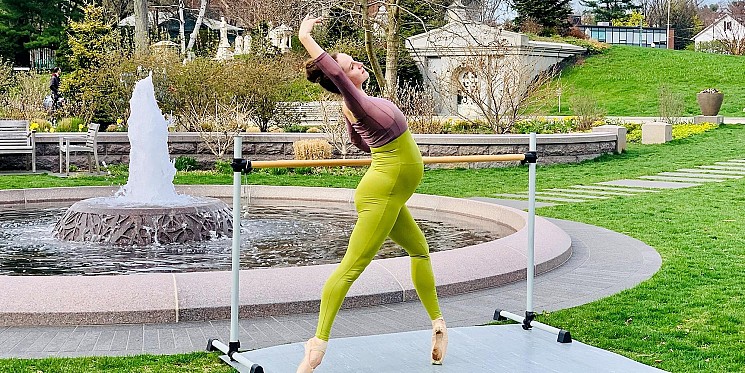
In 2022, we have welcomed seven Artists-in-Residence to create original works inspired by their experiences at Mount Auburn. Meet choreographer and ballet dancer Liz Walker, whose “Dance of Arrival” will feature a behind-the-scenes preview for members on May 15, 2022 and a full performance in the fall.
Tell us about yourself and your work.
I am a lifelong classically trained ballet dancer. I performed for 12 years on and off with Los Angeles Ballet. The bulk of my career there was the 7 years after I had graduated from college. I had a great experience, but being in a ballet company is very all-consuming, and it takes a lot of physical maintenance. So as that time was coming to an end, I moved back here to Cambridge. I knew that I wanted to keep dancing and stay creative. I started picking up a few choreography jobs as a way to keep moving and keep doing projects. And then I found that I really enjoyed creating things, particularly site-specific works that respond to a particular environment. And so, I’ve been doing projects like that over the past several years since I retired from full-time ballet, and have been gaining my own voice as a creator, which has been really rewarding.
Has your performance experience informed your creative process for developing choreography?
I think so. When I’m creating on other people, I remember the experiences I had during my dance career: what was particularly meaningful, what techniques worked, what sort of pet peeves the dancers had when working with a choreographer. I remember how meaningful it was when someone really involved the dancers in the process. And I also try to bring an attitude of positivity and support for the performers I’m working with, because that was what I responded to well as a dancer during a creative process.
Choreographing for myself is different, because I use a lot of video to know what it looks like from the outside. But I think all those years do come into play, of being steeped in the world of a ballet company and understanding what works for the audience, what resonates, and then trying to tap into that as I’m creating.
You are beginning your residency at Mount Auburn partway through your pregnancy (congratulations on both counts)! Could you talk about how this experience is informing your project, “Dance of Arrival”?
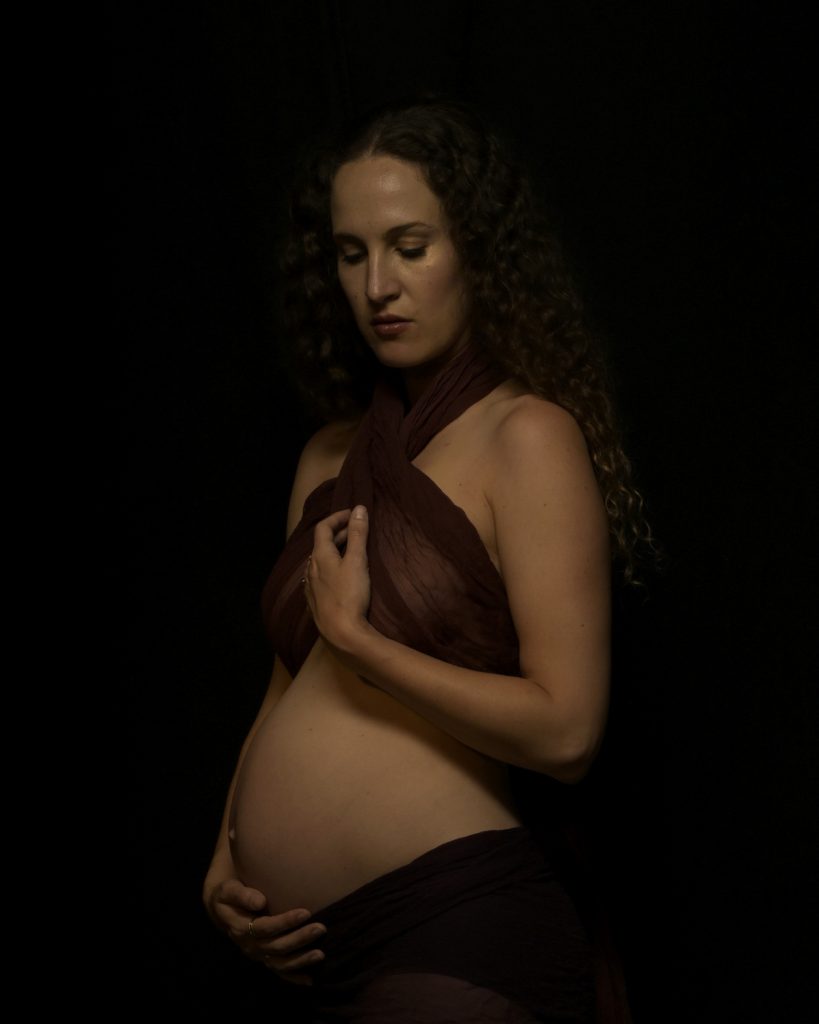
It’s been interesting – I applied towards the end of my first trimester or in the second trimester, which was when my energy levels went way up. So I came in with all these ideas. But then I hit the reality of just how physically restrictive it can be, and how rapid the changes are during the third trimester. So I had to tell myself, I’m just going to do my best with the preview in May, when I’m going to be a little less than a month out from my due date. I obviously want it to be to the best of my abilities, but the best of my abilities is constantly evolving. And as I prepare a more substantial piece in the fall, that will respond to the changes that I’ve undergone giving birth.
So I’m thinking of this as a practice of letting go of control and being okay with that. It adds a layer to the whole project, responding to the changes in my physical abilities. And that’s such a metaphor for life, right? Responding to things as they come up. I don’t know yet firsthand, but I think it’s a metaphor for what parenthood will be, too.
Tell us more about “Dance of Arrival.” Audiences will have multiple opportunities to see your work on this project, starting with the preview event in May. What are you planning for these different programs?
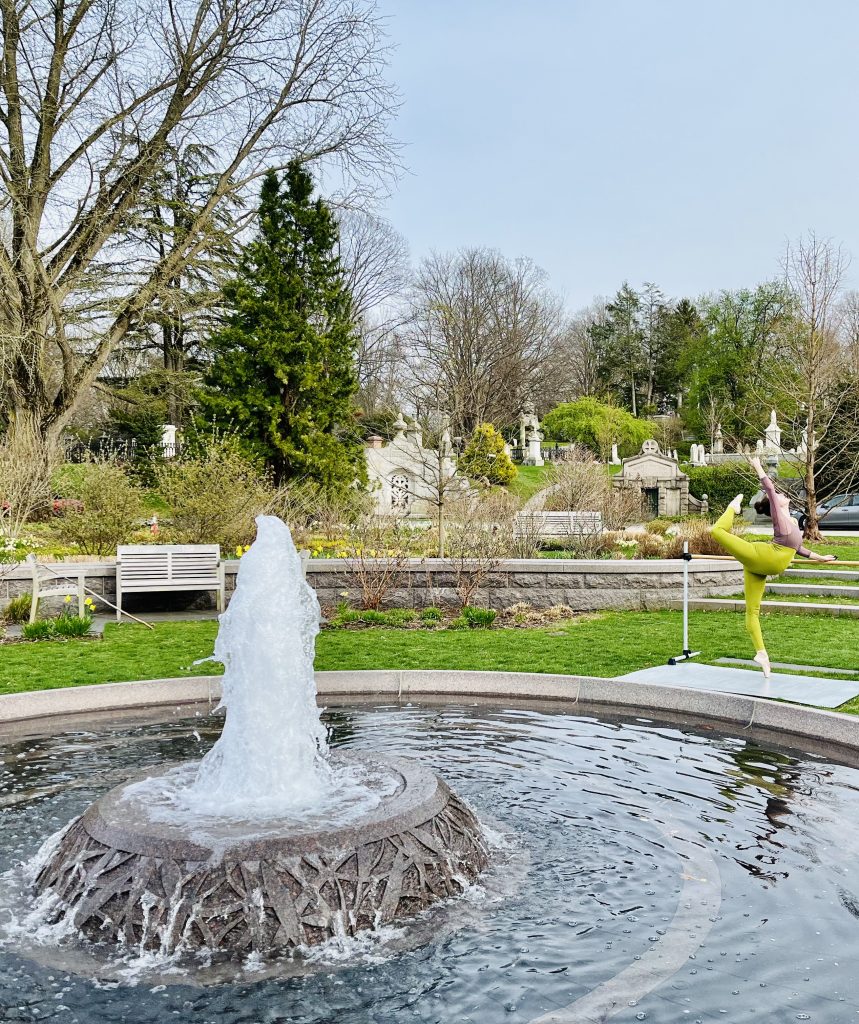
I’ll start with what I’m hoping the larger work will be in the fall. I’d like to structure it as a walking tour with stops along the way that are focused on monuments or residents with an interesting story of motherhood, or an interesting story as a parent and a child. I’m going to work with Mount Auburn staff to select the sites. For example, one potential stop would be at Margaret Fuller’s memorial, where there are very tragic circumstances of her death and her child’s death. A lot of this is balancing the joy of new parenthood and new life with the realities of being in this Cemetery and all the stories that are attached to it.
So at each site, audiences can hear a little bit about what we’re seeing, and then there will be a short dance responding to that site and story. And we’ll move from one stop to the next. All of this will be anchored by a slightly longer dance in Asa Gray Garden. That is the portion I’m aiming to show during the preview this spring.
I’m viewing the preview as a “behind-the-scenes” of my process. It will start with an open warmup where I’m preparing my body to move. That’s definitely evolved with pregnancy, and hopefully it will interesting for people to get a window into that. And then I will perform the piece, which is about 6.5 minutes. At the end there will be a Q&A. It’s a lot of moving pieces, and it should be fun to work on.
What is your process for selecting music for each dance segment?
I have tentatively selected the music for that anchor piece in the garden, capturing a spring theme. But I want to know more about what the stops on the walking tour will be before I think about what music or dance could respond to them.
Typically, what gets me inspired is having the music first, or having concept and music. That anchors me, and then I’ll progress into the choreography and the shape of the piece. But this is a little bit reversed. For the preview portion, I wanted to have the music first. But the little stops along the tour are going to be so responsive to the subject matter, and I might actually create the movement before I select the music. So it’s a little different from how I usually approach creating.
Tell us about your experiences as a visitor to Mount Auburn. What memories or places stand out for you?
I live close by and go for walks often. The day I found out I was pregnant, my husband and I decided to walk there – it just felt like the place to be for this moment. I really remember that day, and this disbelief washing over us – excitement and feeling how momentous this was. It was such a perfect place to process that type of momentous event and emotion.
We’ve come back regularly since that first day. As we’re thinking about baby names, we see these beautiful, often antiquated names on the gravestones, and I always start to imagine people’s lives, and all the stories behind who they were and who their family members were. Even before my pregnancy, I would do that at Mount Auburn, unconsciously. And now it’s taken on a whole other level of significance, knowing that we’re bringing someone from a new generation into the world, among all the history of prior generations.
I love how when I walk at Mount Auburn, I always see something new that I haven’t noticed before. It’s so wonderful to visit and really take your time strolling through. I never feel like I’m in a rush when I’m there. I’m just meandering and seeing what happens. It’s such a special place for that.
Commemorating Simon Antranighian

Memorializing local heritage: creating a monument for Mount Auburn’s first Armenian resident
Mount Auburn is working with a group of Armenian history and culture advocates to erect a monument to daguerreotypist Simon Antranighian (1827 – 1855), the first known Armenian buried at Mount Auburn. He was interred in a public lot in an unmarked grave – the first of more than 3,000 Armenians to be buried here up through today. While this group includes Armenian national heroes, there are also thousands of everyday individuals like Antranighian who helped establish their heritage in the Boston area, which now has the third-largest Armenian population in the United States.
A pioneer who deserves to be remembered
In 1853, the 26-year-old Simon Antranighian arrived in Boston on the clipper ship Sultana from Smyrna (Izmir), Turkey. When he applied for U.S. citizenship the following spring, he stated that he was an “Artist,” born in Constantinople (Istanbul), Turkey, in 1827. Probate records suggest that Antranighian worked as a daguerreotypist (an early type of photographer) and a waiter in what is now Boston’s South Bay.
According to his death record, Antranighian died on March 15, 1855, just 470 days after his arrival. His cause of death was listed as “Infl. of lungs,” which could have been one of several respiratory diseases – including tuberculosis and pneumonia – that were common killers in 19th-century cities.
Antranighian was interred in the public St. John Lot on Vesper Avenue in an unmarked grave. He was the first known Armenian to be buried at Mount Auburn – but not the last.
A community effort
In 2014, volunteer docent Stephen Pinkerton collaborated with Ruth Thomasian of Project SAVE Armenian Photograph Archives and Marc Mamigonian of the National Association for Armenian Studies and Research to present a program celebrating the lives of Armenians buried here, as a centennial commemoration of the Armenian Genocide. It was during this collaboration that Stephen identified Antranighian’s story. After that, they formed an informal “Armenian Friends of Mount Auburn Cemetery” group with fellow advocates to pursue installation of a grave marker for Antranighian, designed by sculptor Robert Shure of Skylight Studios in Woburn, as well as James Holman of Mount Auburn.
Support this project
You can help us make this monument a reality! We are raising funds for the costs of creating the monument and landscaping around it. Your donation will join others from the Watertown community to create this important memorial to our local history.
Help us Complete Phase 3, Indian Ridge Habitat Restoration
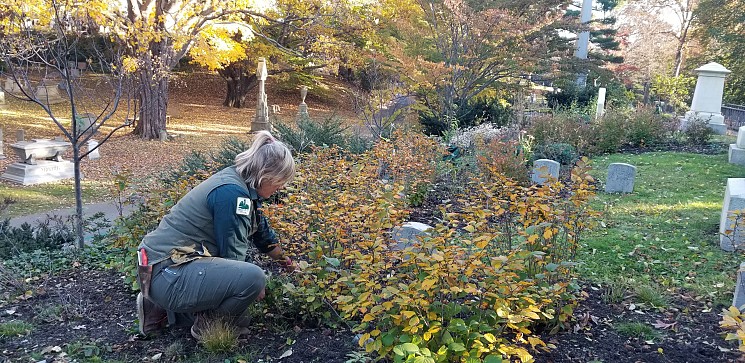
This spring and summer of 2022, we are excited to undertake the third and final phase of our ambitious Indian Ridge Habitat Restoration. Read on to learn what to expect this year, and how you can help us complete this transformative project!
If you have visited in the past two years, you may have noticed our earlier work underway, focused on creating plant communities that would provide both aesthetic and habitat value. Our staff and contractors removed invasive species like Norway Maples from the Ridge and the slopes below it. Replacing them with native shrubs and white-flowered Silverbell trees not only brought a more cohesive aesthetic to the area, but also improved habitat resources for resident and migratory birds.
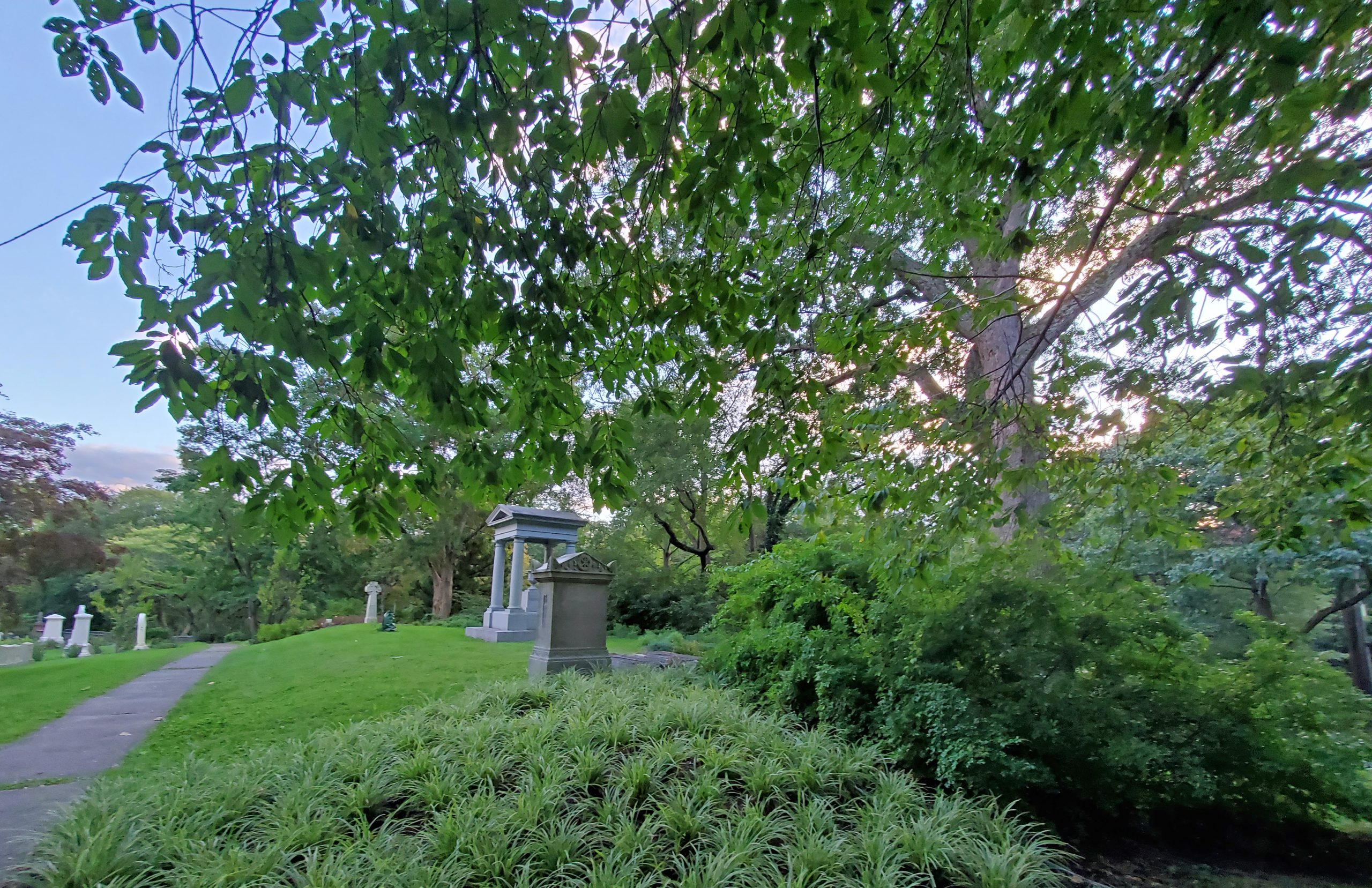
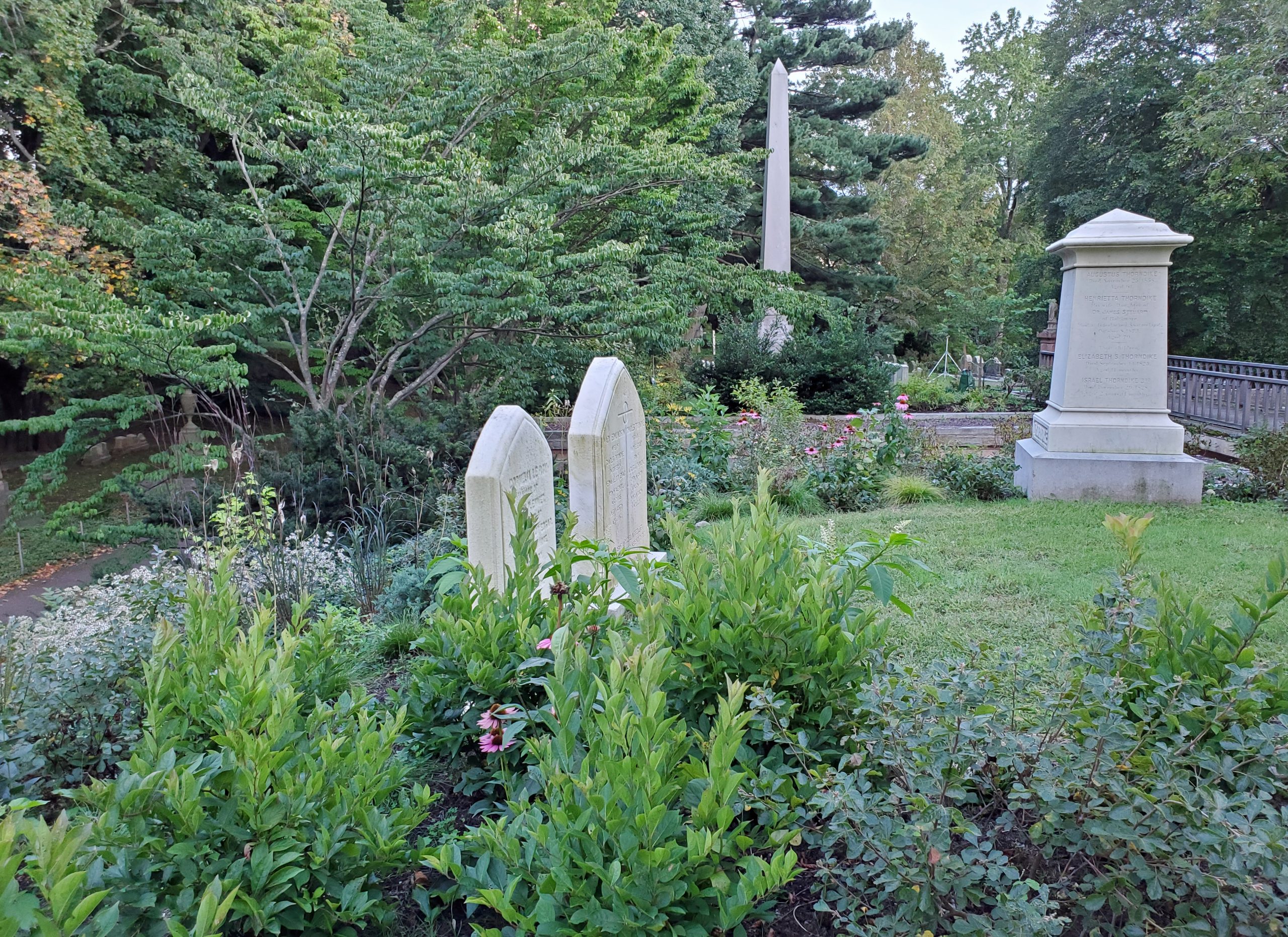
While we have made substantial progress, we still have many areas of plain turf grass in between the replanted sections. We also need to replace the path along the Ridge – currently narrow, damaged in many spots, and made of non-sustainable asphalt. It is therefore time for the final and most impressive phase of this project. Working with the designs and plants already in place (including what has already been added in Phases 1 and 2), we will complete this colorful and diverse landscape for one of our most popular areas, and improve the path for both visitors and staff.
Phase 3 Design – Sedge and Wildflower Meadow
For Phase 3, we turned to Larry Weaner Landscape Associates to create the landscape design. Principal and founder Larry Weaner has been a leading voice in the movement to shift from reliance on turf grass to diverse and ecologically-friendly groundcover. For many years, he has been working with us on the most effective ways to implement turf grass replacement throughout the Cemetery – one section of the landscape at a time, and always with the goal of complementing the monuments, trees, and other features that are already in place.
Larry has worked with Jenna Webster, Senior Associate at Larry Weaner Landscape Associates, to create a native planting scheme that will stretch across the entire 1,800-foot Ridge. It features a sedge and wildflower meadow along with an ambitious series of landscape character zones. These distinct zones – North Ridge Entry, Longfellow Woods, Ridge Meadow, Gardner’s Woods, Auburn Glade, and South Ridge Entry – draw inspiration from the legacy of the Ridge’s historic landscape, including some of its most notable monuments.
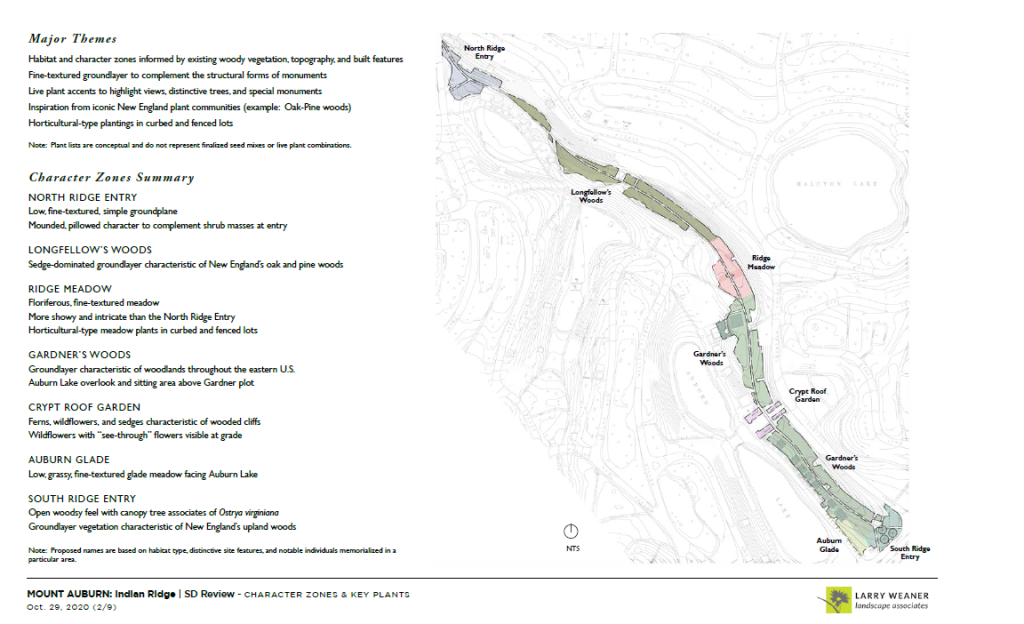
Improving the Path
We will also replace most of the narrow, damaged asphalt path with a permeable paving alternative. Asphalt produces harmful gases during production and installation, and increases the “heat island effect” in urban areas. As part of our commitment to sustainability, we are using a more environmentally-friendly stone aggregate instead. The larger and smoother path can also accommodate more visitors.
What to Expect When
Work on Phase 3 will begin in late spring 2022 with plant installations, which will continue through the summer. Throughout that time, and into the fall, our staff will be providing critical early maintenance for the new plants as needed. Meanwhile, landscape construction company Capizzi & Co. will install the new path at the same time. Please be aware that access to Indian Ridge will be closed during path construction, from June to October 2022.
Support Indian Ridge
You can help make this last step of the Indian Ridge Habitat Restoration a success! By making a gift to this project, you are enabling us to bring this new landscape to life and make the space more enjoyable for everyone. Thank you for your support!
Support Mount Auburn’s Ecology
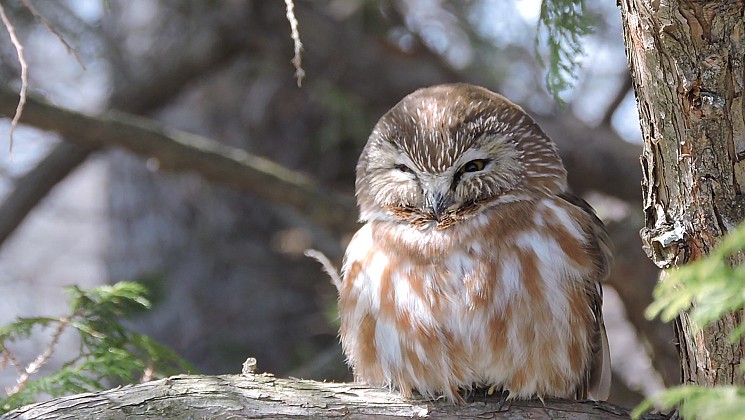
You may come to Mount Auburn to walk or visit a grave, but we humans are just a part of the much larger community that depends on this place. As an urban greenspace, the Cemetery is home to native wildlife both large and small, as well as an important feeding ground for migratory birds. It is just as crucial that we care for these wildlife populations as we do the plants and monuments.
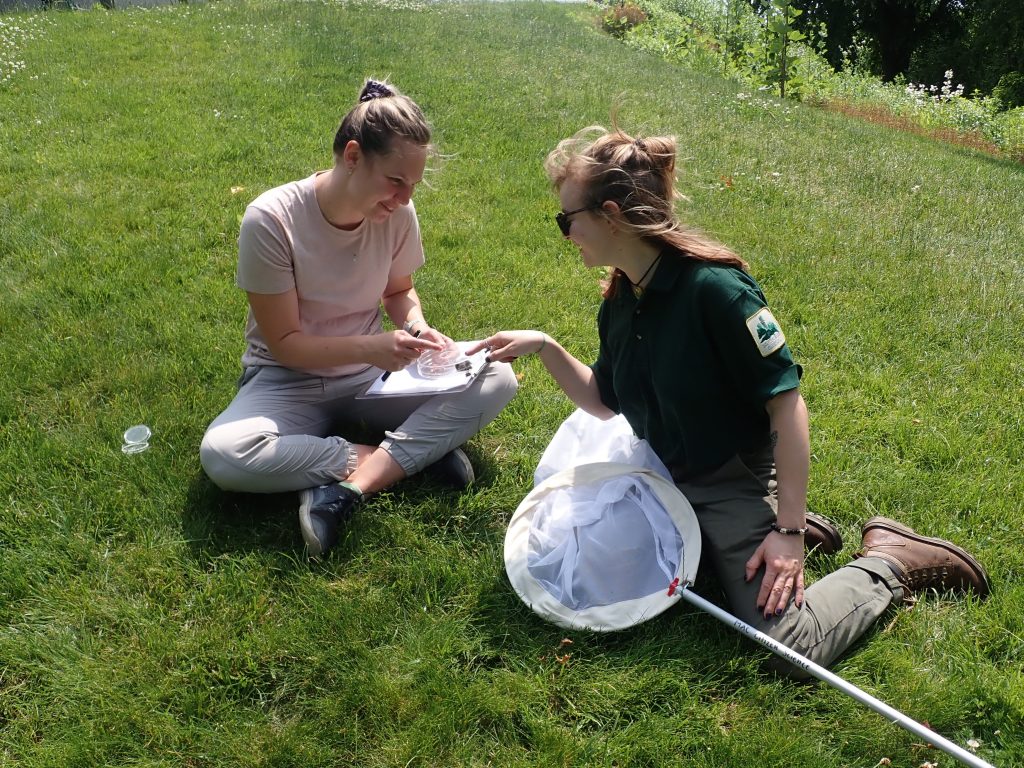
As a leader in the growing field of urban ecology and a resource for local researchers, Mount Auburn plays an important role in stewarding both the flora and fauna of southern New England.
Read on to learn more about the biodiversity work our staff and consulting scientists are undertaking this year. Help us raise the funds to support their projects, and receive a special thank-you gift from us!
The Cemetery: An Ecological Research Center
2022 Biodiversity Studies
Phenology Study *
Breeding Bird Survey *
Amphibian Monitoring *
Eastern Red-Backed Salamander Reintroduction *
Dragonfly Study *
Bat Study *
Arthropod Monitoring *
Pollinator Survey *
Coyote Study
Giant Silk Moth Release Program *
Fungi & Lichens Survey *
Monarchs & Milkweed Monitoring *
Urban-to-Rural Gradient Camera Trap Survey
Winter Bird Survey
*Programs with Citizen Science volunteer opportunities
Mount Auburn has become a unique destination for biodiversity research in the Boston area. Each year, expert scientists work with our staff to study and conserve the precious wildlife populations here, from bats and birds to pollinators and amphibians. Understanding how to care for these diverse species is a key piece of responding to climate change in our environment.
Working alongside them is Mount Auburn’s own corps of Citizen Scientists – trained volunteers who serve as research assistants and public educators. The Citizen Scientist Naturalist Program is open to all ages, providing opportunities for everyone to connect with nature in a meaningful way.
Since adopting our Wildlife Action Plan in 2015, Mount Auburn’s slate of ongoing biodiversity studies has grown from 6 to an astounding 14, ranging from an urban coyote study to the reintroduction of giant silk moths.
Contact pkwiatkowski@mountauburn.org for this year’s volunteer schedule and training opportunities!
How You Can Support Our Wildlife
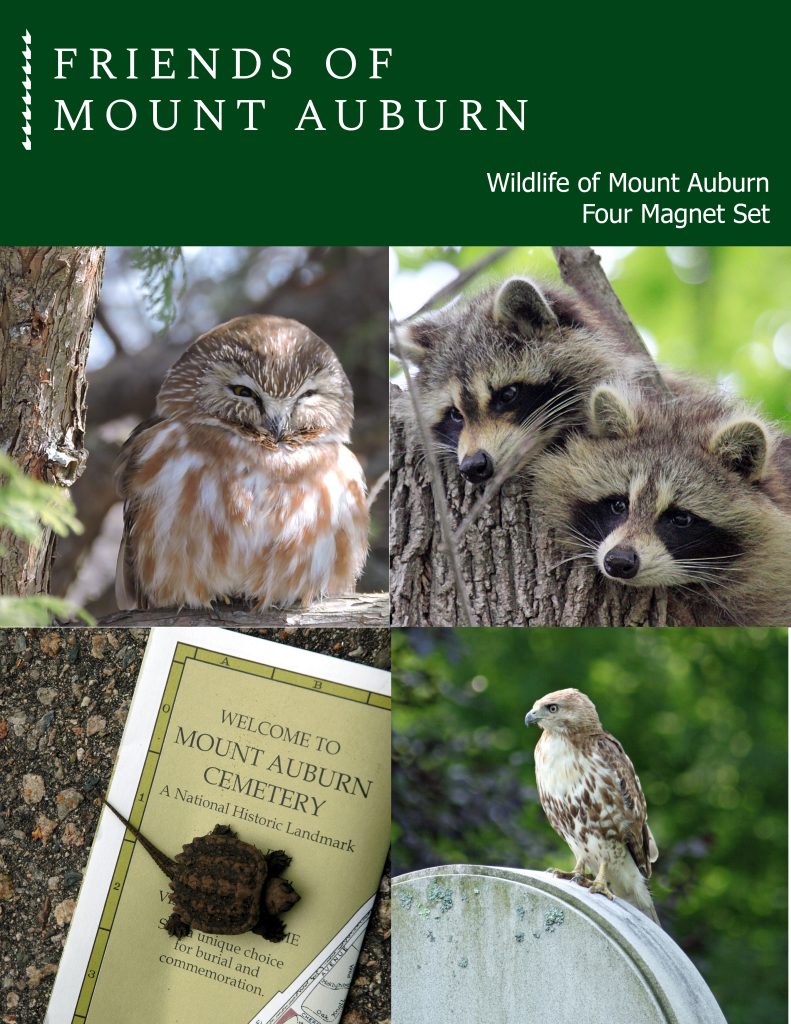
This work does not happen on its own. Generous gifts from our members and donors have allowed our Citizen Science and ecological research program to grow to this point.
You can help us continue this program’s success! Your gift will go directly towards our goal of $15,000 for this year’s studies, volunteer trainings, and consulting researchers. This spring, support our ecology and biodiversity programs with a gift of $120 or more and receive the exclusive Wildlife of Mount Auburn magnet set as our thanks to you. Decorate your fridge or office with images of some of the local species that your gift ensures can continue to call Mount Auburn home.
Learn More: Our Comittment to Biodiversity
Mount Auburn’s 175 acres provide food, water, cover, and nesting sites for a diverse community of urban wildlife. Predators and prey alike are well-represented, allowing the food web to follow its dynamic seasonal cycle. Guided by our 2015 Wildlife Action Plan, Mount Auburn protects and enhances this urban ecosystem and invites a community of researchers and educators to use our grounds as a living laboratory to study biodiversity and climate change.
Mount Auburn’s Biodiversity
Mount Auburn’s Wildlife Action Plan